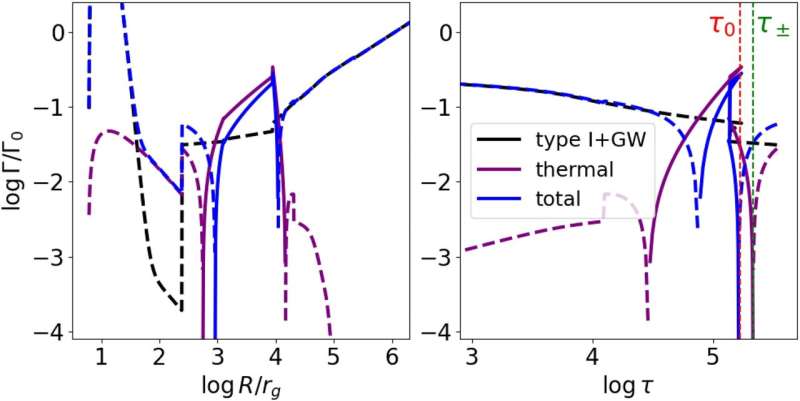Separate normalized torque of M = 107medium size case. The black line shows the combination of Type I torque plus GW torque. The purple line is the thermal torque and the blue line is the total torque. Left: Torsional force plotted in R space. Right: Torsion in space.Vertical dotted line indicates (green) and 0 (red), where migration traps may occur. Credit: Royal Astronomical Society monthly notices (2024). DOI: 10.1093/mnras/stae828
An international study led by Monash University researchers has revealed important insights into the dynamics of black holes within the giant disks at the centers of galaxies.
Published on Royal Astronomical Society monthly noticesThe study shows the complex processes that control when and where black holes slow down and interact with each other, potentially leading to mergers.
The findings reveal the emission of gravitational waves (GW) produced by black hole mergers. These events can be detected by instruments such as the Laser Interferometer Gravitational Wave Observatory (LIGO).
When two black holes get too close, they disrupt space-time itself, emit gravitational waves, and then eventually merge into one.
Dr Evgeni Grishin, a postdoctoral researcher at Monash University’s School of Physics and Astronomy who led the research, compared the phenomenon to a busy intersection without traffic lights.
“We looked at the number and location of these busy intersections,” Dr Grishin said.
This research focuses on the centers of galaxies, where black holes can merge multiple times due to the immense gravitational pull of supermassive black holes at their cores.
In addition, the presence of large gas accretion disks also increases the brightness of these galaxies, classifying them as active galactic nuclei (AGN).
Interactions between smaller black holes and surrounding gas cause them to migrate within the disk and accumulate in regions called migration traps. These traps increase the likelihood of close encounters between black holes, potentially leading to mergers.
Dr. Grishin said: “Thermal effects play a crucial role in this process, affecting the location and stability of migration traps. One implication is that we do not see migration traps occurring in high-luminosity active galaxies. “
The findings of this study advance our understanding of black hole mergers and have broader implications for gravitational wave astronomy, high-energy astrophysics, galaxy evolution and active galactic nucleus feedback.
“Despite these significant discoveries, much about the physics of black holes and their surroundings remains unknown,” said Dr. Grishin. “We are very excited about the results and are now close to discovering where black holes merge in the nuclei of galaxies. One step closer to the way.
“The future of gravitational wave astronomy and AGN research is very promising.”
More information:
Evgeni Grishin et al., Influence of thermal torque on AGN disk migration traps and gravitational wave swarms, Royal Astronomical Society monthly notices (2024). DOI: 10.1093/mnras/stae828
Provided by Monash University
citation: Astronomers discover black hole ‘traffic jam’ at center of Milky Way (2024, April 24), Retrieved April 24, 2024, from https://phys.org/news/2024-04-black-hole-traffic- gactic-centers.html
This document is protected by copyright. No part may be reproduced without written permission except in the interests of fair dealing for private study or research purposes. Content is for reference only.
#Astronomers #discover #black #hole #traffic #jam #center #Milky
Image Source : phys.org
